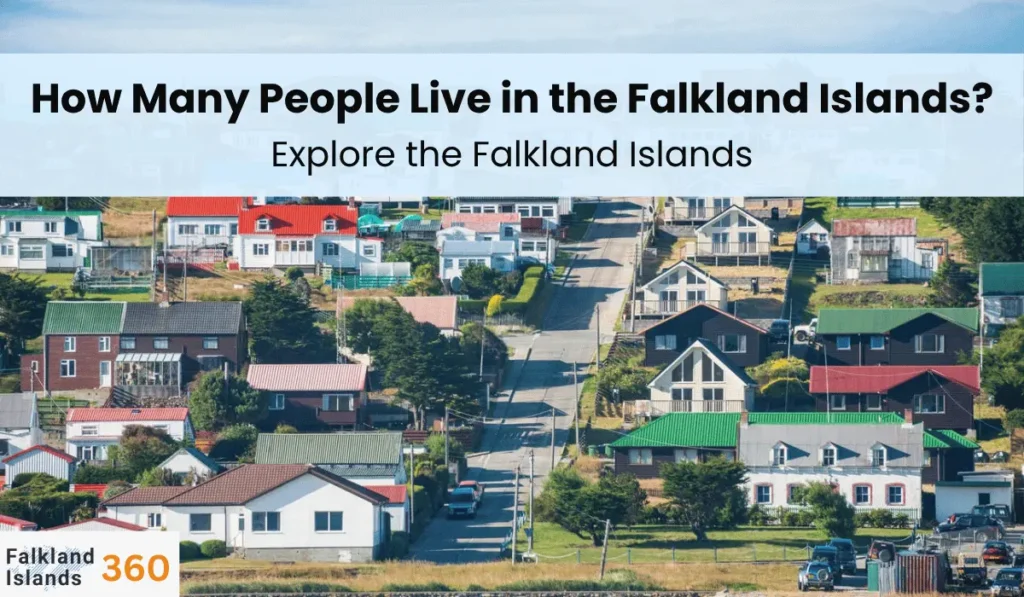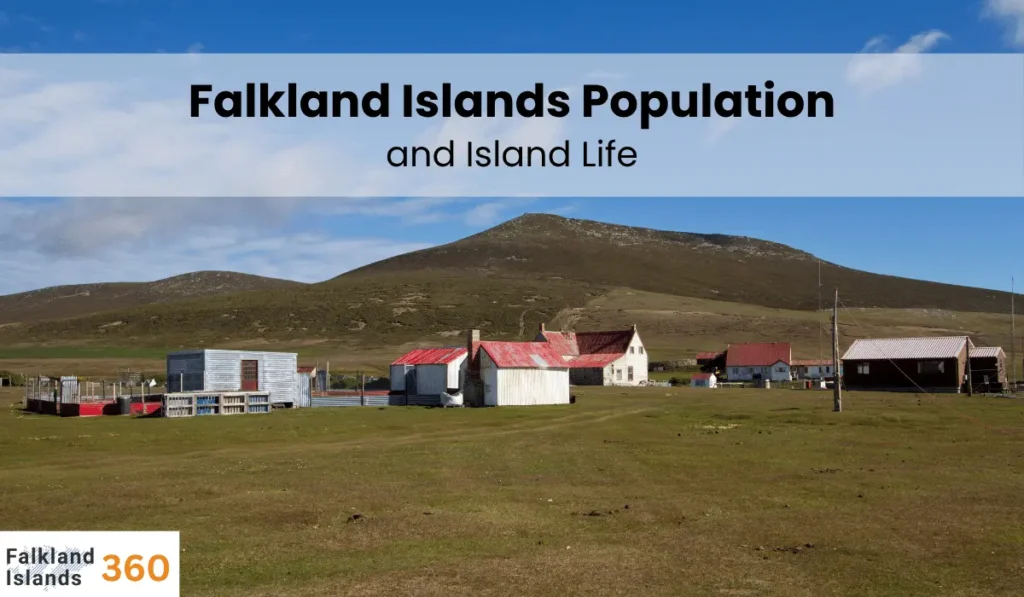The Falkland Islands are a remote British Overseas Territory in the South Atlantic, about 500 km east of Argentina. This subpolar archipelago consists of two main islands (East and West Falkland) and over 700 smaller islands.
With a rugged coastline, abundant wildlife (penguins, albatrosses, seals) and vast sheep ranches, the Falklands are best known for their unique environment and the 1982 conflict between Britain and Argentina. Today the islands are self-governing and famous for their British heritage and natural beauty.
Current Population and Trends
According to the official 2021 census, the Falkland Islands have a very small population. The usually resident population present on census night was 3,142 people. If one includes residents who were temporarily abroad, the total usually resident population is about 3,662.
This was only slightly below the 2016 figure of 3,200, a decrease of about 1.9%. In fact, the census report notes an increase of about 264 people (7.8%) in total usual residents from 2016 to 2021, largely due to net migration. In short, roughly 3,100–3,700 people now call the Falkland Islands home. This makes the Falklands one of the least-populated territories in the world (ranking around 230th).
In recent years the population has hovered around 3,500. The 2021 figure is up from about 3,400 in 2012. The current population of the Falkland Islands has grown overall since 2016 (despite the slight census-night decline) due to immigration of workers in fishing, oil, tourism and government. Notably, the total usually resident population more than doubled since 1980, reflecting decades of inward migration and natural increase.
Demographics
- Age distribution: The Falklands have a relatively young, working-age population. About 16% of residents are children (0–14 years), 72% are of working age (15–64 years) and roughly 12% are seniors (65+). The median age is around 40 years.
- Gender ratio: Males slightly outnumber females. The overall sex ratio is about 110 men for every 100 women. In the capital Stanley the ratio is about 104:100, while the more rural Camp area is 102:100.
- Ethnic/national identity: Most Falkland Islanders are of British descent. In census terms, about 48% identify as “Falkland Islander” (often meaning multi-generational British families on the islands) and 23% as British. Small minorities identify as St. Helenian (7.5%), Chilean (4.6%), or mixed/other (about 8.5%). Over 60 nationalities are represented on the islands, reflecting recent immigration.
- Place of birth: According to the 2021 census, 44.6% of usual residents were born in the Falklands. The largest foreign-born groups come from the United Kingdom (about 21.8%) and Saint Helena (about 11%), with smaller numbers from Chile, the Philippines and elsewhere. In total, residents hail from over 70 countries, underscoring the islands’ multicultural character.
- Language and religion: English is the dominant language (89%), with Spanish spoken by around 7–8%. About 57% of people identify as Christian (mostly Anglican or Catholic), while 35% report no religion.
Historical Context
The Falklands have no indigenous population, the islands were uninhabited until the 18th century. The first European settlements were in 1765 by the British (with a brief French/Spanish presence), and a permanent British administration was established in 1845. Over the next century, small pastoral communities grew, but the population remained under 2,000 until after World War II.
A key historical event was the 1982 Falklands War. Argentine forces invaded the islands on April 2, 1982; British troops retook them on June 14, 1982. Nearly 1,000 lives (Falkland Islanders, British and Argentine) were lost in that conflict. In the decades since, however, the islanders have rebuilt and grown their society. Since 1982 Falkands community has been formed through voluntary immigration and settlement over the course of nearly two hundred years. In fact, modern census data show the population today is more than double what it was in 1980. Most of that growth is due to immigration – many people arriving for jobs in fishing, farming, oil exploration or government chose to stay long-term.
By recent counts, Stanley (the capital) contains about 2,500 people, accounting for over 80% of the population. The remainder live in Camp (the countryside of East and West Falkland) or on offshore bases like Mount Pleasant. Historically, the civilian population peaked at around 3,400 in 2016, dipped slightly by 2021, but overall growth continues to be seen when including overseas residents.
Lifestyle and Culture
Life in the Falkland Islands is shaped by its isolation and close-knit community. Residents generally lead a rural, self-reliant lifestyle. Sheep farming is the traditional backbone of daily life – many families run sheep stations, producing high-quality wool and meat. Home baking (breads, cakes, jams) made with local produce is a way of life, and gardens or greenhouses often supplement supplies.
When times are tough (e.g. bad weather or economic slowdowns), islanders come together for local festivals, sports and community events, which are eagerly anticipated social highlights. Christmas, Liberation Day (June 14) and Remembrance Day bring the community together, with church services, parades, and family gatherings.
Most Falkland Islanders are of British heritage, and British customs are visible everywhere. In Stanley one can even spot classic red telephone boxes, a double-decker bus and traditional pubs reminiscent of a British village. Social life often revolves around small gatherings at these pubs, community centers or the local Stanley cinema. Despite the harsh weather, people enjoy sports like sheepdog trials, rugby, and the quirky local festival “Boots and Slippers” where riders on scooters race through Stanley’s streets (a century-old tradition).
Education and healthcare are free and provided by the government, which contributes to a high standard of living. Unemployment is very low and wages are relatively high compared to global levels – the economy supports a modern lifestyle. According to official reports, the islands enjoy low unemployment and the workforce is about 80% British expatriates and locals. Many households have internet access, satellite TV and other amenities, despite the archipelago’s remoteness.
In short, Falkland Islanders (often called “Kelpers”) enjoy a largely outdoor, family-oriented lifestyle with strong community ties. Over half the population was born and raised on the islands, and many others who came here on work contracts stayed permanently because they “enjoyed the way of life so much”. People from more than 60 countries now live in the Falklands, making it a surprisingly diverse society. Yet all share a common love of the islands’ landscapes, wildlife and the islander spirit of independence and resilience.
Challenges Facing the Population
Despite its strengths, the Falkland Islands population faces several challenges:
- Geographic isolation: The islands’ remote location and small size pose logistical hurdles. Everything from food to building materials must be shipped long distances. Air and sea transport are limited and often affected by weather. This isolation drives up living costs and makes it hard to attract skilled specialists (doctors, engineers, etc.) for short-term jobs.
- Economic sustainability: The economy depends heavily on natural resources. Fishing (especially squid) accounts for a large majority of exports, while sheep farming (wool and meat) is also vital. A surge in tourism has helped diversify the economy, but it is still small-scale. Commodity price swings or international disputes (e.g. fishing licenses) can therefore affect jobs and incomes. The islands are hopeful about offshore oil, but until significant oil revenues arrive, economic growth will need to balance environmental concerns.
- Environmental vulnerability: The Falklands’ environment is fragile. Overfishing (especially by illegal vessels) threatens marine life, and introduced grazing animals (sheep, reindeer) and plants can damage native habitats. Climate change also poses long-term risks (changing weather patterns, sea level rise). The government has launched sustainability initiatives (e.g. the Green Seal tourism scheme), but managing waste, conserving wildlife and adapting infrastructure remain ongoing issues.
- Small population base: With only ~3,500 people, there is a limited workforce and consumer market. Essential services (healthcare specialists, secondary schools, etc.) cannot always be offered locally, sometimes requiring travel abroad for treatment or education. A small population can also mean a high dependency on each new generation of workers. However, it also means a tight-knit society where people look out for one another and civic participation is high.
Overall, the islands’ residents balance these challenges with community support and prudent planning. The Falkland government actively invests in infrastructure (new air links, housing) and education to sustain the population. Still, analysts note that continued growth largely depends on immigration and encouraging young people to stay after completing their education.
Conclusion
In summary, only a few thousand people live in the Falkland Islands, roughly 3.1 to 3.7 thousand as of 2021. This tiny population has a unique demographic profile (mostly working-age adults of British descent) and enjoys a high standard of living despite the islands’ remoteness. The population has grown modestly over recent decades due to immigration, and today the community is remarkably diverse given its size. Islanders take pride in their way of life, a blend of rural simplicity, strong community bonds, and environmental stewardship.
To learn more about Falkland Islands population and culture, visit the Falkland Islands Government website or the official tourism site. These resources provide detailed census data, historical background and even local news updates. Exploring the Falklands further, whether through government reports or travel guides, reveals a remarkable society thriving at the edge of the world.


